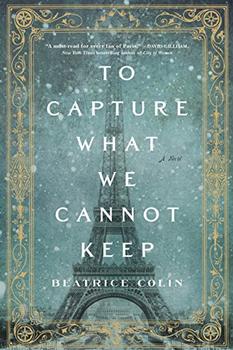Summary | Excerpt | Reading Guide | Discuss | Reviews | Beyond the book | Read-Alikes | Genres & Themes | Author Bio

To Capture What We Cannot Keep is a fascinating historical fiction novel set against the backdrop of the construction of the Eiffel Tower. There, one of Gustav Eiffel's chief engineers and architects for the tower, Émile Nouguier, becomes involved with Mrs. Caitriona (Cait) Wallace. Cait is a young widow, employed as the chaperone for Alice and Jamie, the niece and nephew of the renowned Scottish engineer William Arrol, while they are abroad.
Boiled down to its barest parts, this book borders on the romance genre. In fact, all the main characters seem to get involved in one relationship or another (or after another, as the case may be). There's no shortage of intrigues and scandals and secrets, as well as a few scenes taking place in the bedroom. However, Beatrice Colin carefully skirts around all of this, and remains safely within the literary, historical fiction genre through several methods.
First, she's done enough research into both Nouguier and Arrol to make her fictional choices of the gaps in their biographies plausible. We know that Nouguier was single and that he worked closely with Eiffel on the tower; we know that William Arrol had no children of his own, and left most of his company and fortune to his nieces and nephews. We also know that two such well-known engineers would have known about each other, and certainly, they were all familiar with Eiffel himself. All of this makes it reasonable to accept that Arrol would agree for Jamie to apprentice with Nouguier on the Tower. Then there is the fictional Cait, a woman whose husband died in the collapse of Arrol's Tay Bridge, which puts her in contact with Arrol himself who, out
of guilt, decides to give her some kind of employment, while indulging two of his younger family members. All of this makes sense, and lays the groundwork for the romance and intrigue to come.
Another way Colin firmly stays within the literary, historical genre is through the building of the Eiffel Tower itself. By employing the building process as the timeline for the story, and using the real personalities involved, she disburses, throughout the story, some of the real dilemmas and obstacles this project faced, along with interesting pieces of information about the construction. For example, she talks about the enormity of work that went into preparing all of the pieces that made up this historic structure. In addition, the anxious day when the first cross-platform was lowered into place is beautifully described. This piece of construction connected the four leaning legs of the structure, thereby stabilizing the whole tower. Colin's imagination seems to be extremely accurate in terms of the precision that was required to achieve this feat. It is reasonable to assume that Nouguier was worried about that day professionally, so adding some personal apprehension along with it only added to the drama.
The balance of the combination of all these essential elements enriches the story, which succeeds most of the time. The extra bonus is how gently Colin writes her prose, which I found to be sophisticated without being bombastic. Poetic interludes, describing the scenery and settings, work well without sounding clichéd. Colin's use of language also fits with the era she writes about, and helps contribute to the overall atmosphere of the book.
With all this praise, it might seem like this novel should be getting a full five stars. Unfortunately, I can't give it that because I felt To Capture What We Cannot Keep doesn't build dramatically enough towards the climax, making the action leading to the conclusion and the aftermath feel slightly flat. Aside from this, I believe Colin does a laudable job with believable characters, a compelling plot, and an excellent mixture of fact and fiction.
![]() This review was originally published in The BookBrowse Review in January 2017, and has been updated for the
November 2017 edition.
Click here to go to this issue.
This review was originally published in The BookBrowse Review in January 2017, and has been updated for the
November 2017 edition.
Click here to go to this issue.

If you liked To Capture What We Cannot Keep, try these:

by Cathy Marie Buchanan
Published 2014
Set at a moment of profound artistic, cultural, and societal change, The Painted Girls is a tale of two remarkable sisters rendered uniquely vulnerable to the darker impulses of "civilized society." In the end, each will come to realize that her salvation, if not survival, lies with the other

by Elizabeth Kostova
Published 2010
Kostova's masterful new novel travels from American cities to the coast of Normandy, from the late 19th century to the late 20th, from young love to last love. The Swan Thieves is a story of obsession, history's losses, and the power of art to preserve human hope.
The whole problem with the world is that fools and fanatics are always so certain of themselves, and wiser people ...
Click Here to find out who said this, as well as discovering other famous literary quotes!
Your guide toexceptional books
BookBrowse seeks out and recommends the best in contemporary fiction and nonfiction—books that not only engage and entertain but also deepen our understanding of ourselves and the world around us.